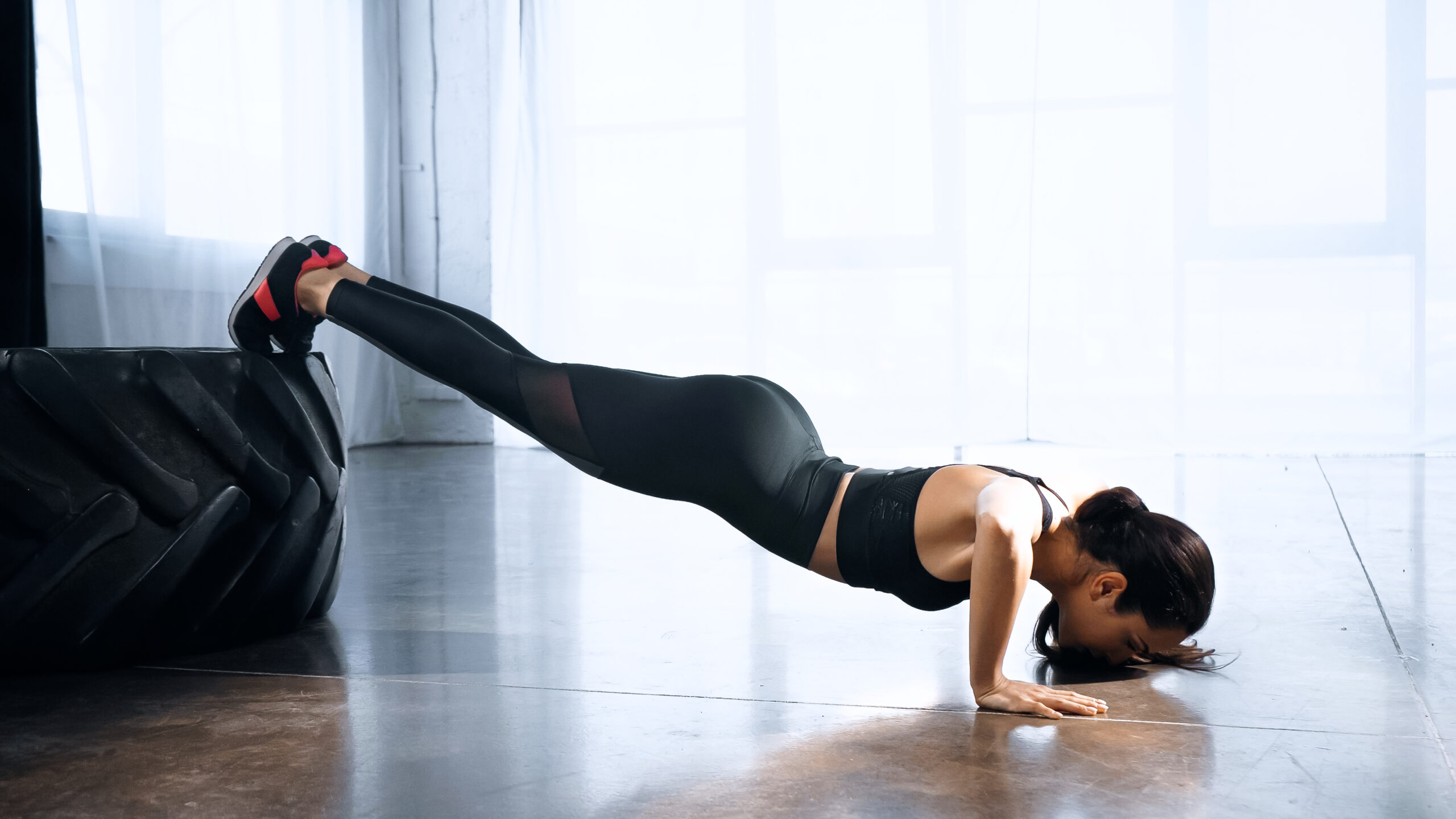Decline push ups are a variation of the traditional push up exercise that targets the muscles in the chest, triceps, and shoulders.
In comparison to traditional push ups, decline push ups provide a greater range of motion due to the inclined position of the body.
This increased range of motion can help to increase muscle activation and improve flexibility in the chest, triceps, and shoulders.
The steeper the incline of the surface, the more challenging the exercise will be.
This makes decline push ups a useful exercise for athletes and fitness enthusiasts looking to progress their push up strength and muscle development.
Additionally, the decline position of the exercise puts more emphasis on the upper portion of the chest, making it a useful exercise for targeting and developing the upper chest muscles.
Decline push ups are a compound push exercise, meaning they involve multiple joint movements and engage multiple muscle groups.
In addition to the chest, triceps, and shoulders, decline push ups also engage the core muscles to maintain proper body alignment and stability during the exercise.
How to do a decline push up correctly
Here are 6 steps for properly performing a decline push up:
- Choose a step or bench that is appropriate for your fitness level. If you are new to this exercise, start with a lower incline and gradually increase the incline as you become stronger.
- Make sure your hands are positioned slightly wider than shoulder-width apart. This will help to engage the chest muscles and reduce strain on the shoulders.
- Keep your body straight and tight throughout the exercise. Engage your core muscles to maintain proper body alignment and avoid letting your hips sag or rise too high.
- As you lower your body, keep your elbows close to your body and avoid letting them flare out to the sides. This will help to target the chest and tricep muscles effectively.
- As you push up, focus on squeezing your chest and tricep muscles to fully extend your arms and lift your body back to the starting position.
- As you repeat the exercise, focus on maintaining good form and proper body alignment. If you begin to feel fatigue or struggle to maintain proper form, consider taking a short break or reducing the number of reps before continuing.
The importance of good form
Maintaining good form during decline push ups is crucial for effectively targeting the muscles in the chest, triceps, and shoulders and minimizing the risk of injury.
Here are a few additional tips to help you maintain good form during the exercise:
- Keep your feet and hands positioned on the step or bench to maintain proper body alignment.
- Avoid letting your back arch or round as you lower and push up. This can cause strain on the lower back and reduce the effectiveness of the exercise.
- Don't let your head drop or lift too high. Keep your neck in line with your spine and focus on a spot a few inches in front of your hands to help maintain proper body alignment.
- Engage your core muscles throughout the exercise to help stabilize your body and maintain proper form.
- Take your time and focus on the quality of each rep rather than rushing through the exercise. This will help you to maintain proper form and get the most out of the exercise.
By following these tips and focusing on good form, you can effectively perform decline push ups to strengthen and develop the muscles in your chest, triceps, and shoulders.
Remember to listen to your body and adjust the intensity of the exercise as needed to ensure that you are challenging yourself without risking injury.
What muscles work during a decline push up?
Decline push ups are a compound exercise that engages multiple muscle groups in the upper body. Here are the main muscles that are activated when doing decline push ups:
- The chest muscles: They are the primary muscle group targeted during decline push ups. These muscles are responsible for pushing movements and are engaged as you lower and push up during the exercise.
The pectorals are divided into two main parts: the upper pectorals, which are located on the upper portion of the chest, and the lower pectorals, which are located on the lower portion of the chest. The decline position of the exercise puts more emphasis on the upper pectorals, making it an effective exercise for targeting and developing this muscle group. - The triceps: They also play a role in the decline of push up exercise. These muscles are responsible for extending the elbow joint and are engaged as you push up from the lowered position. Strong triceps can help to improve upper body strength and muscle definition.
- The shoulders: They are also engaged during decline push ups. The deltoids are responsible for shoulder movement and stability, and are engaged as you push up from the lowered position. Strong shoulder muscles can help to improve posture and reduce the risk of upper body injuries.

What are the benefits of decline push ups?
There are several benefits to incorporating decline push ups into your fitness routine:
- Improved upper body strength: The inclined position of the decline push up requires more strength and stability to complete the exercise, leading to increased muscle strength in the chest, triceps, and shoulders.
- Greater range of motion: The decline position allows for a greater range of motion in the push up, which can help to increase muscle activation and improve flexibility.
- Enhanced muscle definition: As with any resistance exercise, this exercise can help to build and define muscle mass in the upper body.
- Improved posture: Strong chest, tricep, and shoulder muscles can help to improve posture and reduce the risk of upper body injuries.
- Increased muscle endurance: Decline push ups can help to improve the endurance of the muscles in the chest, triceps, and shoulders. As you perform more reps and sets, your muscles will become better able to handle the demands of the exercise, leading to improved endurance and strength.
- Improved cardiovascular health: Like all resistance exercises, decline push ups can help to improve cardiovascular health by increasing heart rate and improving blood flow.
- Enhanced functional movement: Strong chest, tricep, and shoulder muscles are essential for everyday movements such as lifting, pushing, and pulling. By incorporating decline push ups into your routine, you can improve the functional movement of these muscles and reduce the risk of injury.
- Improved bone density: Resistance exercises such as this one can help to increase bone density, which can reduce the risk of osteoporosis and other bone-related conditions.
How often should I decline push ups?
To determine the frequency of decline push ups that is right for you, consider your fitness level and goals.
As a general rule, if you are new to the exercise, it is recommended to start with one or two sets of 8-12 reps, performed two or three times per week.
As you become more comfortable with the exercise and your strength improves, you can gradually increase the intensity by increasing the number of sets and reps or adding more days of decline push ups to your routine.
To ensure that you are getting the most out of the exercise, here are some additional tips to keep in mind
Some more information
- Gradually increase the intensity: As you become more comfortable with decline push ups and your strength improves, try increasing the number of reps or sets you perform. You can also try using a steeper incline or adding a resistance band to increase the difficulty of the exercise.
- Vary the angle of the incline: To challenge different muscle groups and add variety to your routine, try varying the angle of the incline when performing decline push ups.
- Incorporate other upper body exercises: In addition to decline push ups, consider adding other upper body exercises such as dips, chin ups, and rows to your routine to work different muscle groups and create a well-rounded workout.
- Listen to your body: It is important to listen to your body and adjust the intensity and frequency of your decline push ups as needed. If you feel tired or sore, consider taking a day of rest or reducing the number of reps or sets you perform.
By following these tips and finding a balance that works for you, you can effectively incorporate decline push ups into your fitness routine and continue to see improvements in your upper body strength and muscle development.
How should I progress my decline push up?
To progress with this exercise there are many things you can do, some of them are:
- Increase the number of reps: Gradually work up to performing more reps per set.
- Add a resistance band: Place a resistance band around your back to increase the difficulty of the exercise.
- Increase the incline angle: As you become more comfortable with decline push ups and your strength improves, try using a steeper incline to increase the difficulty of the exercise.
- Use a stability ball: Instead of using a bench or step, try performing decline push ups on a stability ball. This will challenge your balance and stability and engage additional muscles in your core.
- Try plyometric push ups: Once you have mastered traditional decline push ups, you can try adding a plyometric element to the exercise by explosively pushing up from the lowered position. This will increase the intensity and challenge your muscles in a different way.
- Add weight: To further increase the difficulty of the exercise, you can try adding weight to your body by wearing a weighted vest or holding a weight plate during the exercise.
- Try one-arm decline push ups: (very advanced) Once you have mastered the traditional decline push up, you can try performing the exercise with one arm at a time to further challenge your balance and stability.
Variations and Alternatives
There are also several bodyweight alternatives to decline push ups that can be incorporated into your routine to provide similar benefits. Some options include:
- Incline push ups: Instead of placing your feet on an elevated surface, place your hands on a raised platform such as a bench or box. This exercise targets the same muscles as the decline push up, but with a different angle of incline.
- Plyometric push ups: Plyometric push ups involve exploding off the ground and clapping your hands together at the top of the movement. This exercise is more advanced and requires more power and coordination, but can be modified by placing your hands on an incline to make it more accessible.
- Dips: Dips are another exercise that targets the chest, triceps, and shoulders. They can be performed using parallel bars or a dip station, or modified by using a bench or step.
Dangers of Decline Push ups
While decline push ups are a challenging and effective exercise, they may not be suitable for everyone.
Those with wrist or elbow injuries may find the exercise uncomfortable or painful, and may need to modify the exercise or choose an alternative exercise.
It is important to listen to your body and consult with a healthcare professional or certified fitness instructor if you have any concerns about your ability to perform this exercise.
Conclusion
Overall, decline push ups are a challenging and effective exercise for strengthening the upper body and improving muscle definition.
By practicing good form and progressively increasing the difficulty of the exercise, you can continue to see improvements in your strength and muscle development.

Leave A Comment